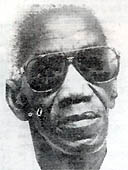
Oscar Pyle
By TERRY JOSEPH
EVERY stage of pan research and development requires close collaboration between tuners, scientists and scholars attached to other disciplines. In the many instances where the language of any one group is alien to another, the process is slowed.
It was expressed as anxiety by veteran pannists at the recent International Conference on the Science and Technology of the Steelpan. Conference chairman Dr Anthony Achong of the University of the West Indies (UWI) and Professor Thomas Rossing of Northern Illinois University’s Department of Physics both sought to explain that they were only interpreting in a scientific way, what the tuners had long discovered.
Pan pioneer Oscar Pyle said he feared that pan tuners would not get enough out of the discussions, because so much of it would fly over their heads. Former Pan Trinbago public relations officer, Selwyn Tarradath’s concern was that Trinidad and Tobago does not have the technology to follow-up on the information provided by exchanges at the conference.
El Dorado Senior Comprehensive School steelband manager, Fazal “Moosh” Mohammed took quite another view. “I feel that we must start the collaboration from the level of the school’s music teacher and physics teacher, so that a better understanding of the instrument could come from both sides, with the physics teacher getting the scientific information and breaking it down for the music students,” he said.
The Mohammed position is easily the best option here. Even when the proceedings of the conference become available, there is a good chance that no pan tuner will be able to grasp the complexities of quadratic equations, or would feel that he has to, just so he could tune the next instrument.
Felix Rohner’s experiments with gas nitriding provides us with a handy example of the gaps that must be bridged, if the conference is to mean anything to the very artisans whose work the scientists are studying. Rohner, a Swiss pan researcher, has adapted a process known in his country’s culture for the past 80 years for improving the tolerance of steel. Gas nitriding, exposing the drum to sub-zero blasts of liquid nitrogen, rather than heating it over an open flame, has produced measurable results no different from the rustic procedure. The nitriding process gives the pan better wear resistance, increased resistance to metal fatigue and corrosion and produces instruments with good note stability, due to the high tensile strength and yield point of the steel.
The process is hardly a secret, since it is used in Switzerland to make things as basic as cowbells, but transfer of the technology could prove prohibitive in cost and a major intellectual challenge for the basic Trini tuner. Rohner’s set of pans cost US$10,000.
To be able to study the behaviour of notes and improve their shapes and resonance, your neighbourhood tuner must understand linear, quadratic and cubic forces and read the results of holographic infometry; if he is to appreciate what the scientists were saying to him at the three-day talks. But a lot of that information may not be necessary to the tuner, if the kind of collaboration suggested by the various presenters at the conference comes to pass. Prof Rossing repeatedly called for pans at various stages of the tuning process to be sent to his laboratories at NIU for testing at every sequence. Exactly which tuner is going to take up a $4,000 instrument and donate it to science is unclear, but it is the only way these processes can be tested or improved.
At present, research at UWI is largely funded by the determination of those scientists who care to invest personal funds and time into their projects. Achong, Derek Gay, Clemont Imbert, Brian Copeland, Fasil Muddeen – to name a few – are undertaking studies on various aspects of the preparation of a steel pan and the behaviour of its notes under impact. For the conference, they were joined by Prof Rossing, Uwe J. Hansen, professor emeritus, Dept. of Physics, Indiana State University, Rohner and others; all of whom share a commonality of language and perspective. They spoke freely about harmonically related parametric excitations on the notes, detuning and tonal structure, modal analysis and acoustical radiation in the first morning alone. That afternoon, talks included findings from studies on finite element modeling of pan acoustics, holographic imaging, sand patterns and microphone scanning, modes of vibration, polar response, sound spectra of bass pans, the dynamical equivalent of the steel instrument and an electronic “score sheet” for pan.
The real work that remains, therefore, probably lies with UWI’s professors of language, who will now demystify the science as a way of replacing well-entrenched myths about pan.
HIDING PAN FACTS UNDER CANOPIES PT - 1
MIKING SOLO INSTRUMENTS PT - 2
SQUABBLES OVER STANDARDISATION PT - 3
Trinicenter.com | Pantrinbago.com